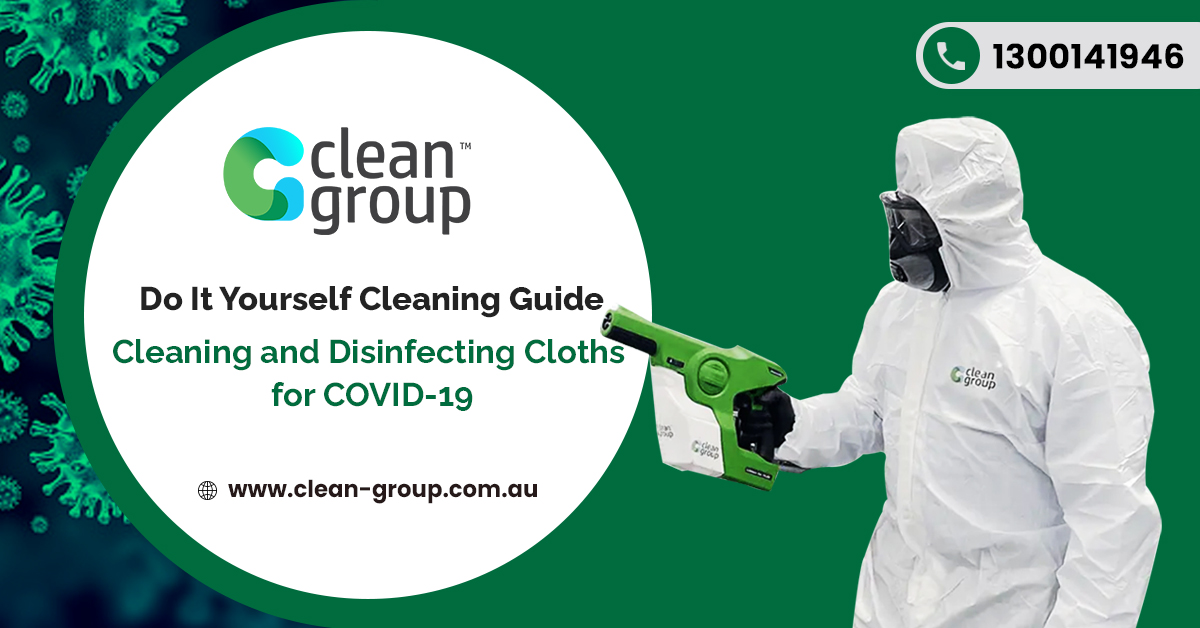While the COVID-19 pandemic is slowly getting better thanks to the effort of medical professionals worldwide, we still have a long way to go until we can safely go out without having to worry about catching the virus.
Thankfully, we now have a lot of resources that allow us to take care of ourselves at home, at our workplace, and even if we go out. Following these measures can help us stay calm and safe during these uncertain times. For more information, you can also visit our website:
One of the most frequently asked questions is: “how do you clean and disinfect things for COVID-19?” Logically, hygiene is extremely important to take care of if you want to avoid the virus as much as possible. However, there are way too many online portals that give you information on that matter.
Safe Work Australia has given us a wide list of measures we can take to use Covid-19 cleaning and disinfecting cloths safely at our home or workplace. If you’re unsure of how to comply with standard cleaning and disinfecting guidelines in your area, keep reading this DIY guide!
Difference Between Cleaning and Disinfecting
First, it’s important for us to clear up the difference between cleaning and disinfecting. It may not seem like it, but a lot of people tend to confuse both terms.
Cleaning, in general, involves removing germs or dirt from particular surfaces, including clothes, tables, and others. Keep in mind that cleaning does lower the risk of the object spreading viruses, but it doesn’t kill them if they’re already there.
On the other hand, disinfecting involves using chemicals specifically designed to kill these bacteria.
According to Safe Work Australia, the primary infection method for COVID-19 is through contact with respiratory droplets, which happens when a person infected with the virus sneezes or coughs.
While you can avoid this by wearing your mask and applying social distancing, there’s still another way to get the virus if you’re not careful.
Overall, you can get infected with the COVID-19 virus if you touch a surface contaminated with the virus. Keep in mind that you’re not going to get the virus by touching that surface, but you can get it if you get your contaminated hand and touch your mouth, nose, or eyes. This is why it’s so important to wash your hands as frequently as possible.
Promoting a Healthier and Cleaner Space
Whether you’re at home or your office, one of the best ways to protect everyone from the risk of exposing themselves to the virus is to implement appropriate disinfecting and cleaning measures. If you combine both methods, you can most likely promote a healthier environment.
Workplaces and homes should be cleaned at least daily. Depending on the case, using detergent and water for routine cleaning is enough. However, you may sometimes need disinfection to assess the problem accurately.
Another thing that can influence your cleaning method is the likelihood of contaminated items in your space. Remember that the COVID-19 virus can survive on some particular surfaces for quite some time.
Using Cleaning and Disinfecting Solutions
You don’t need to worry about having to buy strange chemicals to protect yourself from the virus. The Therapeutic Goods Administration (TGA) recently published a list of some disinfectants that may be effective against the virus.
However, you’re good to go as long as you use a disinfectant solution that contains at least one of the chemicals listed on the TGA’s list. Most people use a 2-in-1 detergent and disinfectant solution, so you may lookout for those.
With the exception of healthcare workplaces, you may use water and detergent for routine cleaning. Still, remember that this may not be enough to kill the virus.
In case you want to clean and disinfect your space after a suspected contamination case, you must ensure you’re wearing appropriate personal protective equipment (PPE).
These pieces of equipment include safety eyewear and disposable gloves.
What Areas Should You Clean?
Generally speaking, you must clean any surface that is frequently touched by people. These surfaces include door handles, counters, tabletops, elevator buttons, desks, toilets, remotes, phones, and more.
Moreover, any surface that has visible dirt on it must be cleaned immediately to avoid any future problems. As mentioned before, you must clean these surfaces at least once a day.
You must always prioritise those areas over less-frequented ones. While it’s important for you to clean everything, you must first go over the things you tend to touch the most during the day. It may surprise you how many things we touch while we’re at home or our office!
If you’re unsure of whether a surface is frequently touched or not, it’s always best to treat it as if it was and clean it right away. In case one of your surfaces hasn’t been touched in days, you don’t necessarily have to clean it during your routine cleaning jobs. Still, try your best to keep everything clean.
What Is the Right Product to Use?
As we mentioned several times throughout this page, detergent and water are good for cleaning. However, if you’re looking for a thorough disinfection process, you may need to use particular products, such as the ones from the TGA list.
Some disinfectants you may use on hard surfaces include alcohol with at least 70% of concentration, chlorine bleach in 1000-parts-per-million concentration, oxygen bleach, and others. If you go into a store, some disinfectants may claim to have ‘antiviral activity,’ meaning they kill viruses.
However, keep in mind that not all of those products can claim they can kill viruses. If you want to be sure, make sure you check the TGA’s list.
Some people try using sanitisers as a disinfectant. While sanitisers are chemicals that may kill some viruses or bacteria, they’re not as strong as disinfectants. If you’re looking to disinfect yourself, a sanitiser is a better option. Otherwise, go for a disinfectant for hard surfaces.
Try not to use extreme heat as a method to kill the virus. While it has been proven that heat can destroy COVID-19, it isn’t too practical to use.
Cleaning and Disinfecting General Hard Surfaces
Keep in mind that cleaning and disinfecting isn’t as hard as it may seem. As long as you have the right equipment and patience, you may get it over with in under a few minutes.
Generally speaking, you’re going to use a combination of damp dust and detergent to clean. Simply use the detergent solution to clean the surface thoroughly as you would with regular cleaning.
Once you’re done, and if you want to disinfect the area, use the disinfectant you bought and spray some into the surface you want to clean. You may then use a cloth to spread the disinfectant solution all over the surface.
Remember to prioritise frequently touched surfaces or items before going over other things. If you’re cleaning electronics, such as a microwave, make sure you use disinfectant only on the outside surfaces so that you don’t damage anything.
More Post : Signs of a Highly Professional Business Cleaning Company
Disposing of Cleaning and Disinfecting Materials
Once you’re done cleaning and disinfecting everything you need, it’s critical for you to dispose of some of the things you used to clean.
If you have any disposable cleaning materials, try to throw these away immediately. In the case of any personal protective equipment and covers, you must try to wash them in a regular cycle wash using a warm setting, if possible.
Moreover, if you used reusable, non-washable eye protection, make sure you wipe it clean with a detergent solution and then cover it with disinfectant. Once you’re done, you may leave it to air dry. If there are any residues left, you may wait until the disinfectant has dried to use more detergent.
Here, you may use regular washing detergent. Try not to shake any of the washable items before throwing them into the washing machine.
Cleaning and Disinfecting Cloths
Logically, you may have used different cloths for cleaning your home or office. If you’re using items like disposable wipes, you must throw these away immediately. However, if you’re using washable and reusable cloths, the process is fairly simple.
As with PPE, you must put all of the cloths you used for cleaning in a washing machine. Try to use a regular cycle wash with the warmest setting possible. You may use regular washing detergent as well.
It’s vital to note that you must always wear disposable gloves before handling used cloths or any other protective equipment. Once you remove those gloves, wash your hands with soap and water for at least 20 seconds.
Cleaning Clothes
A lot of people don’t know what to do in terms of cleaning clothes. Keep in mind that’s it’s currently unclear how long the virus can survive on different fabric types. However, some clothing pieces have metal or plastic elements that may allow the virus to live for a few hours.
As with the process of dealing with used cloths, make sure to handle dirty clothes with disposable gloves and put all of those into a washing machine in the warmest setting possible.
Make sure you’re not shaking dirty clothes before throwing them into the machine.
More Post: Healthy School Environment Important for Students in Australia
General Precautions While Cleaning
The following is a list of precautions everyone must take before cleaning and disinfecting areas, according to Safe Work Australia guidelines:
- If you’re cleaning on -or around- electrical equipment, make sure you isolate that equipment and turn off any power sources if possible. Remember you’re using liquids, so cleaning electronics while they’re on can cause some problems.
- Follow the detergent/disinfectant’s manufacturer usage instructions and recommendations.
- Get a copy of the Safety Data Sheet (SDS) for your cleaning/disinfectant solutions.
- Wear the right personal protective equipment (PPE) to protect yourself correctly in the process.
Bottom Line
As long as you take care of yourself and your environment, you’re likely to avoid the COVID-19 virus for the most part. If you’re looking to clean your surfaces yourself, make sure to follow all of the guidelines provided on this page!

